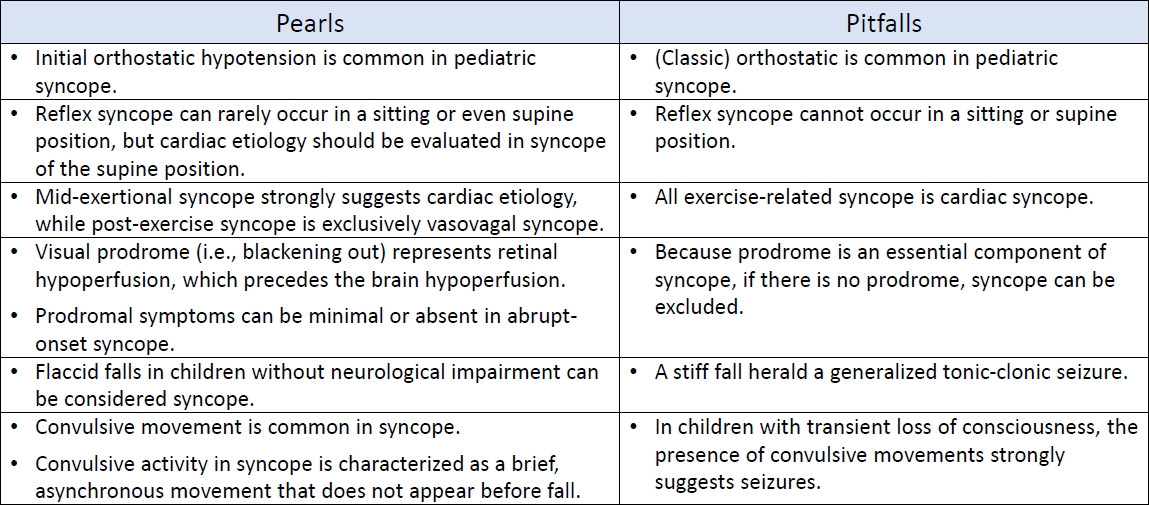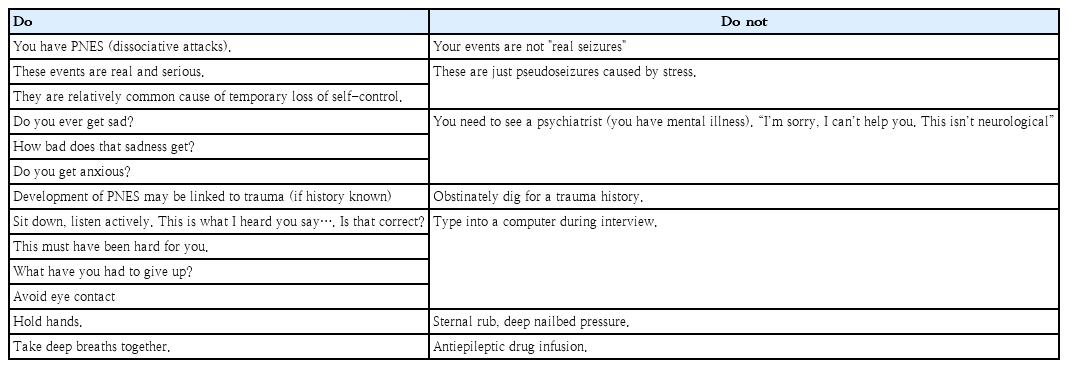Search
- Page Path
-
- HOME
- Search
- Original Article
- Developmental and Behavioral Medicine
- Parenting stress and interactive engagement behaviors in children with developmental delay
- Jung Sook Yeom, Rock Bum Kim, Jae Young Cho, Ji Sook Park, Eun Sil Park, Ji-Hyun Seo, Jae-Young Lim, Hyang-Ok Woo
- Clin Exp Pediatr. 2023;66(6):252-261. Published online May 19, 2023
-

· Question: What level of parenting stress is experienced by parents of children with developmental delays (DDs) without autism spectrum disorder, and what factors contribute to it?
· Findings: Parents of children with DDs experienced high parenting stress that were significantly mediated by their children’s low interactive behaviors.
· Meaning: The interactive behaviors of children with DDs mediate parenting stress.
- Review Article
- Neurology
- Pediatric syncope: pearls and pitfalls in history taking
- Jung Sook Yeom, Hyang-Ok Woo
- Clin Exp Pediatr. 2023;66(3):88-97. Published online February 15, 2023
-

An accurate diagnosis depends on correct history taking and its interpretation. An in-depth understanding of the symptoms of syncope in connection with its pathophysiology can lead to avoiding critical pitfalls in the diagnostic process of history taking.
- Myths and truths about pediatric psychogenic nonepileptic seizures
- Jung Sook Yeom, Heather Bernard, Sookyong Koh
- Clin Exp Pediatr. 2021;64(6):251-259. Published online October 17, 2020
-

• Psychogenic non-epileptic seizures (PNES) are events that look like epileptic seizures but are not caused by abnormal electrical discharges.
• PNES are a manifestation of psychological and emotional distress.
• Treatment for PNES does not begin with the psychological intervention but starts with the diagnosis and how the diagnosis is delivered.
• A multifactorial biopsychosocial process and a neurobiological review are both essential components when treating PNES
- Cardiology
- Understanding the importance of cerebrovascular involvement in Kawasaki disease
- Jung Sook Yeom, Jae Young Cho, Hyang-Ok Woo
- Clin Exp Pediatr. 2019;62(9):334-339. Published online May 16, 2019
-

Kawasaki disease (KD) is a systemic vasculitis in infants and young children. However, its natural history has not been fully elucidated because the first case was reported in the late 1960s and patients who have recovered are just now entering middle age. Nevertheless, much evidence has raised concerns regarding the subclinical vascular changes that occur in post-KD patients. KD research...
- Case Report
- Neurology
- Mild encephalopathy with a reversible splenial lesion in a girl with acute pyelonephritis
- Jung Sook Yeom, Chung Mo Koo, Ji Sook Park, Ji-Hyun Seo, Eun Sil Park, Jae-Young Lim, Hyang-Ok Woo, Hee-Shang Youn
- Clin Exp Pediatr. 2018;61(2):64-67. Published online February 28, 2018
-
We report the case of a 12-year-old girl who had mild encephalopathy with a reversible splenial lesion (MERS) associated with acutepyelonephritis caused by
Escherichia coli . The patient was admitted with a high fever, and she was diagnosed with acute pyelonephritis based on pyuria and the results of urine culture, which detected cefotaxime-sensitiveE. coli . Although intravenous cefotaxime and tobramycin were...
- Infection
- Distinctive clinical features of HPeV-3 infection in 2 neonates with a sepsis-like illness
- Jung Sook Yeom, Ji Sook Park, Ji-Hyun Seo, Eun Sil Park, Jae-Young Lim, Chan-Hoo Park, Hyang-Ok Woo, Hee-Shang Youn, Ok Jeong Lee, Tae-Hee Han, Ju-Young Chung
- Clin Exp Pediatr. 2016;59(7):308-311. Published online July 31, 2016
-
We report a human parechovirus-3 (HPeV-3) infection in 2 neonates who had prolonged fever (>5 days) with palmar-plantar erythema. This distinctive rash was observed 4–5 days after fever onset, just before defervescence. Elevated aspartate aminotransferase, lactate dehydrogenase, and ferritin levels were characteristic laboratory findings in the 2 cases, suggesting tissue damage caused by hypercytokinemia. Case 1 was treated with intravenous...
- Review Article
- Neurology
- White matter injury following rotavirus infection in neonates: new aspects to a forgotten entity, 'fifth day fits'?
- Jung Sook Yeom, Chan-Hoo Park
- Clin Exp Pediatr. 2016;59(7):285-291. Published online July 31, 2016
-
That rotavirus infection can cause neurological symptoms in young children has been well established. However, it is surprising why rotavirus infection has been overlooked as a cause of neonatal seizures for many years, despite significant research interest in neonatal rotavirus infection. Neonates are the age group most vulnerable to seizures, which are typically attributed to a wide range of causes....
- Original Article
- Neurology
- Factors associated with mumps meningitis and the possible impact of vaccination
- Kyuyol Rhie, Heung-Keun Park, Young-Soo Kim, Jung Sook Yeom, Ji Sook Park, Ji-Hyun Seo, Eun Sil Park, Jae-Young Lim, Chan-Hoo Park, Hyang-Ok Woo, Hee-Shang Youn
- Clin Exp Pediatr. 2016;59(1):24-29. Published online January 22, 2016
-
Purpose Mumps meningitis is a common complication of mumps infection; however, information on mumps meningitis in the postvaccine era is limited. The purpose of the present study was to determine factors associated with mumps meningitis and to discuss the effect of vaccination on this disease.
Methods We retrospectively reviewed patients younger than 19 years with mumps, diagnosed at a university hospital in Korea...
- Case Report
- The first pediatric case of tularemia in Korea: manifested with pneumonia and possible infective endocarditis
- Jung Sook Yeom, Kyuyol Rhie, Ji Sook Park, Ji-Hyun Seo, Eun Sil Park, Jae-Young Lim, Chan-Hoo Park, Hyang-Ok Woo, Hee-Shang Youn
- Clin Exp Pediatr. 2015;58(10):398-401. Published online October 21, 2015
-
Tularemia is a potentially severe zoonotic disease caused by
Francisella tularensis . A lack of awareness about tularemia can be embarrassing and could result in delayed treatment because of improper diagnosis. The diagnosis of tularemia is difficult, because the infections are rare and the clinical spectrum is broad. As only 1 adult case has been reported in Korea thus far, pediatricians...
- Original Article
- Prevalence of human parechovirus and enterovirus in cerebrospinal fluid samples in children in Jinju, Korea
- Ji-Hyun Seo, Jung Sook Yeom, Hee-Shang Youn, Tae-Hee Han, Ju-Young Chung
- Clin Exp Pediatr. 2015;58(3):102-107. Published online March 20, 2015
-
Purpose Human parechovirus (HPeV) and enterovirus (EV) are causative agents of a sepsis-like illness in neonates and of infections of the central nervous system in young children. The objectives of this study were to assess the prevalence of HPeV3 and EV infection in young children with a sepsis-like illness or with meningitis in Jinju, Korea.
Methods Cerebrospinal fluid (CSF) samples were collected from...
- Review Article
- Kawasaki disease in infants
- Jung Sook Yeom, Hyang Ok Woo, Ji Sook Park, Eun Sil Park, Ji-Hyun Seo, Hee-Shang Youn
- Clin Exp Pediatr. 2013;56(9):377-382. Published online September 30, 2013
-
Kawasaki disease (KD) is an acute febrile illness that is the predominant cause of pediatric acquired heart disease in infants and young children. Because the diagnosis of KD depends on clinical manifestations, incomplete cases are difficult to diagnose, especially in infants younger than 1 year. Incomplete clinical manifestations in infants are related with the development of KD-associated coronary artery abnormalities....
- Original Article
- Orthostatic symptoms does not always manifest during tilt-table test in pediatric postural orthostatic tachycardia syndrome patients
- Tae-Eon Huh, Jung Sook Yeom, Young-Soo Kim, Hyang-Ok Woo, Ji Sook Park, Eun Sil Park, Ji-Hyun Seo, Jae-Young Lim, Chan-Hoo Park, Ki-Jong Park, Hee-Shang Youn
- Clin Exp Pediatr. 2013;56(1):32-36. Published online January 29, 2013
-
Purpose Chronic day-to-day symptoms of orthostatic intolerance are the most notable features of postural orthostatic tachycardia syndrome (POTS). However, we have encountered patients with such symptoms and excessive tachycardia but with no symptoms during the tilt-table test (TTT). We aimed to investigate whether POTS patients with chronic orthostatic intolerance always present orthostatic symptoms during the TTT and analyze the factors underlying...
- Case Report
- Signal change in hippocampus and current source of spikes in Panayiotopoulos syndrome
- Jung Sook Yeom, Youngsoo Kim, Ji Sook Park, Ji Hyun Seo, Eun Sil Park, Jae Young Lim, Chan-Hoo Park, Hyang Ok Woo, Hee-Shang Youn, Oh-Young Kwon
- Clin Exp Pediatr. 2012;55(2):63-67. Published online February 14, 2012
-
A 4-year-old girl with Panayiotopoulos syndrome presented with a history of 4 prolonged autonomic seizures. The clinical features of her seizures included, in order of occurrence, blank staring, pallor, vomiting, hemi-clonic movement on the right side, and unresponsiveness. A brain magnetic resonance imaging (MRI) showed a slightly high T2 signal in the left hippocampus. Interictal electoencephalogram revealed spikes in the...
- Successful treatment by exchange transfusion of a young infant with sodium nitroprusside poisoning
- Jong Geun Baek, Hoar Lim Jeong, Ji Sook Park, Ji Hyun Seo, Eun Sil Park, Jae Young Lim, Chan Hoo Park, Hyang Ok Woo, Hee Shang Youn, Jung Sook Yeom
- Clin Exp Pediatr. 2010;53(8):805-808. Published online August 31, 2010
-
Although sodium nitroprusside (SNP) is often used in pediatric intensive care units, cyanide toxicity can occur after SNP treatment. To treat SNP-induced cyanide poisoning, antidotes such as amyl nitrite, sodium nitrite, sodium thiosulfate, and hydroxycobalamin should be administered immediately after diagnosis. Here, we report the first case of a very young infant whose SNP-induced cyanide poisoning was successfully treated by...
- Original Article
- Incidence of congenital heart disease in the western part of Gyeongnam Province in Korea
- Sun Hwa Jang, Jae Hui Kim, Jung Sook Yeom, Eun Sil Park, Ji Hyun Seo, Jae Young Lim, Chan Hoo Park, Hyang Ok Woo, Hee Shang Youn
- Clin Exp Pediatr. 2008;51(8):848-855. Published online August 15, 2008
-
Purpose : The objective of this study was to ascertain the incidence of congenital heart disease in the western part of Gyeongnam Province in Korea. Methods : We enrolled 849 children (M:F=390:459) who were diagnosed with congenital heart disease (CHD) and received echocardiography during January 1997 to December 2005 in Gyeongsang National University Hospital. The subjects were limited to patients born... -
- Clinical characteristics of acute renal failure of rhabdomyolysis in children
- Jae Hui Kim, Min Ji Goo, Jung Sook Yeom, Eun Sil Park, Ji Hyun Seo, Jae Young Lim, Chan Hoo Park, Hyang Ok Woo, Hee Shang Youn
- Clin Exp Pediatr. 2007;50(3):277-283. Published online March 15, 2007
-
Purpose : Acute renal failure (ARF) is an important complication of rhabdomyolysis. The purpose of this study was to identify the major causes of rhabdomyolysis in children and to identify the factors associated with the developmet of ARF. Methods : A retrospective chart review between January 1997 to June 2005 was conducted of 60 patients with a diagnosis of rhabdomyolysis. Rhabdomyolysis... -
-

-
-

-

-
Impact Factor4.2
-
6.52022CiteScore92nd percentilePowered by







